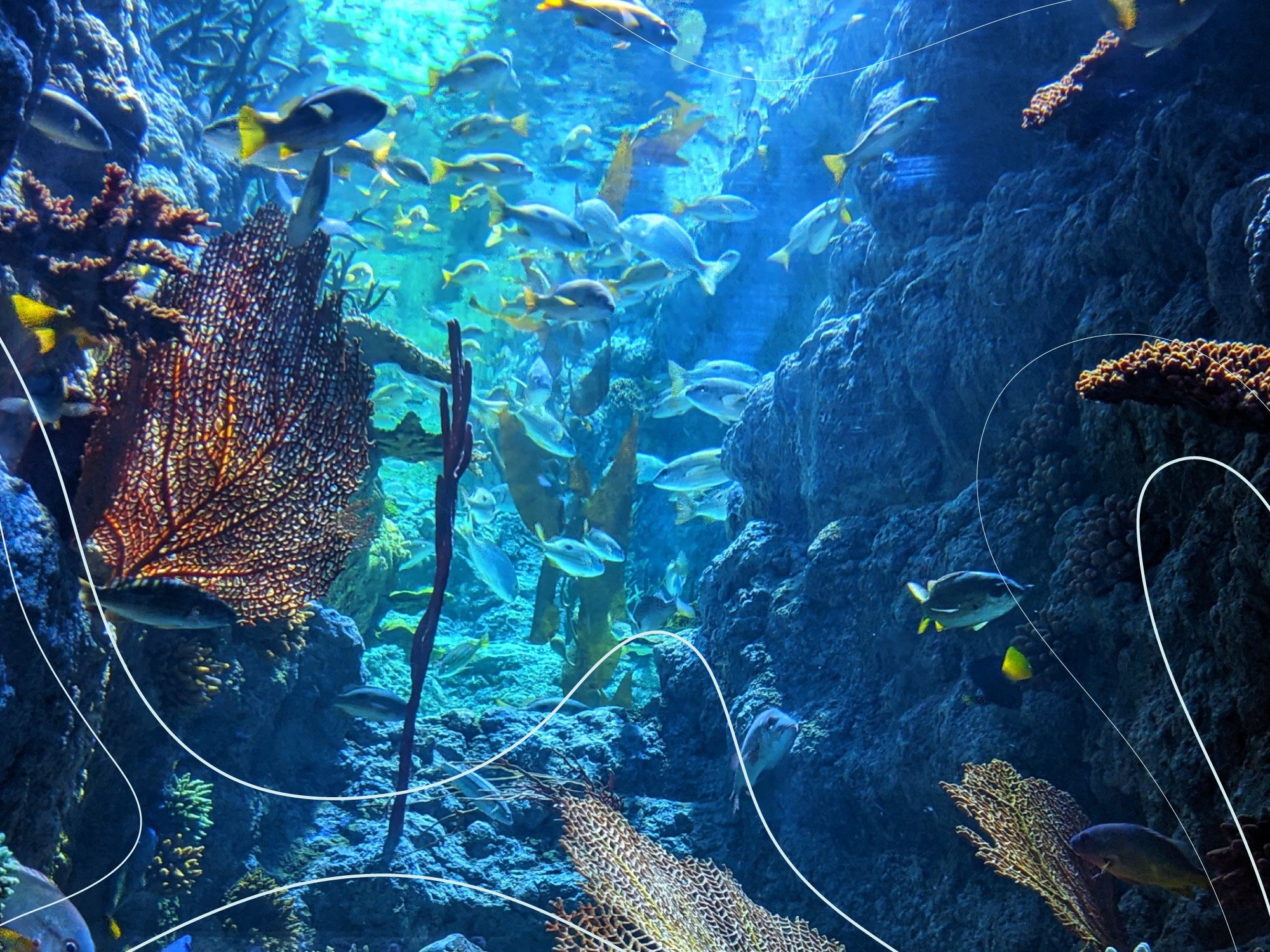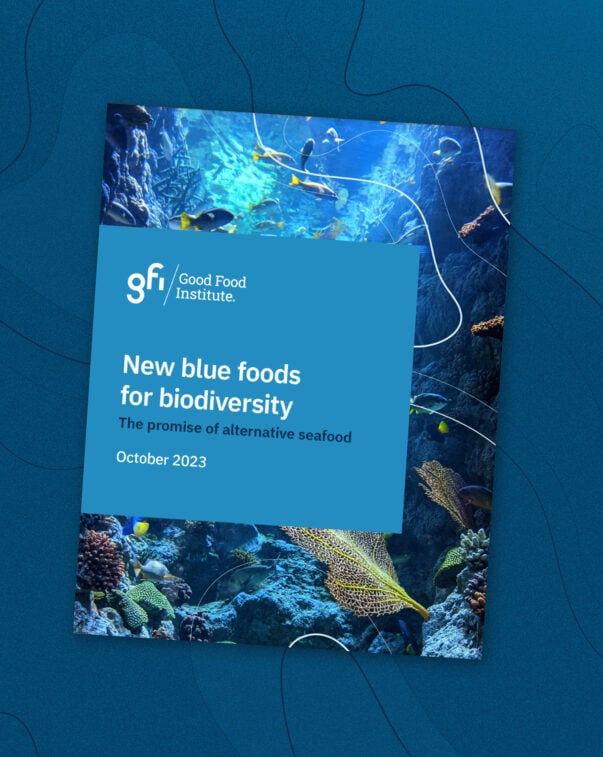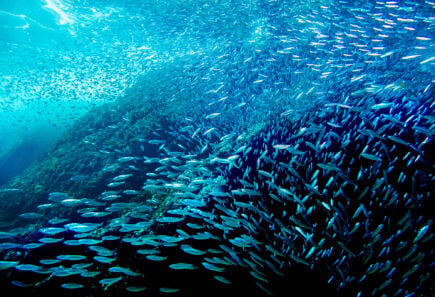
Biodiversity benefits of alternative seafood
The rising global demand for seafood is stretching the production capacity of our ocean and coasts beyond sustainable limits and threatening biodiversity. Plant-based and cultivated seafood can help fill the growing gap with a significantly smaller environmental footprint.
Read our white paper brief
Diversifying the supply with alternative seafood can help protect biodiversity
Biodiversity is declining across the globe: More than one million species are in danger of extinction,1 and one-third of all plant and animal life alive today may be extinct by 2070.2 Protecting and restoring biodiversity will require transforming our global food system in ways that decrease waste, increase sustainability and efficiency,3 and enable a diversity of ecosystems to recover and thrive.
And just as a diverse and sustainable food system is critical for biodiversity, biodiversity is foundational to a productive and resilient food system. Indeed, biodiversity loss can lead to food scarcity, nutritional deficits, economic insecurity, and international conflict.4 It can even increase the risk of human exposure to zoonotic pathogens.5
This white paper investigates the interactions of our seafood supply chain with marine habitats. The author explores the potential biodiversity benefits of accelerating plant-based and cultivated seafood, which could relieve the pressure on coastal and open ocean ecosystems and help create a more resilient and equitable food system.
Seafood consumption outpaces population growth — and conventional production capacity
As the human population grows, incomes rise, and the average lifespan increases, so too does the demand for seafood. For the past 60 years, the global growth rate of seafood consumption has outpaced population growth, and global seafood production is now projected to increase by 14 percent between 2020 and 2030.
However, our one shared ocean has a limited capacity to feed a growing population. While stronger governance, innovations in science and technology, and market incentives have improved the sustainability of fisheries and aquaculture in some areas, growing pressure on natural and human resources is still rapidly degrading the productivity and resilience of ocean and coastal ecosystems—and the diversity of life that depends on them.
“One-third of all plant and animal life alive today may be extinct by 2070.”
Román-Palacios, Cristian, and John J. Wiens. “Recent Responses to Climate Change Reveal the Drivers of Species Extinction and Survival.” Proceedings of the National Academy of Sciences 117, no. 8 (February 25, 2020): 4211–17.
How alternative seafood may help stem biodiversity loss
Ocean and coastal environments offer a range of ecosystem services upon which life depends—from the oxygen we breathe to the food we consume to the water we drink. However, anthropogenic pressures are driving an unprecedented decline in global marine biodiversity, and the loss of genetic, species, and ecosystem biodiversity threatens the productivity and resiliency of ocean ecosystems.
New and novel strategies are needed to reverse this biodiversity loss trend. This white paper details how alternative seafood offers an opportunity to reduce our environmental footprint and restore marine biodiversity and ecosystem functionality through:
- The protection and recovery of marine species
- Decreased habitat loss, pollutants, and land use
- Reduced greenhouse gas emissions and ocean acidification
- Lower biocide and antimicrobial use while scaling alternative seafood production
Opportunities to advance alternative seafood in ocean conservation policies and programs
Support from governments, nonprofits, academia, and industry will be necessary to realize the potential of cultivated and plant-based seafood as accessible, affordable, and sustainable alternatives.
Stakeholders focused on interdependent (but often siloed) issues such as biodiversity conservation, seafood sustainability, climate resilience, food security, and sustainable livelihoods can accelerate progress across all of these areas by working together to advance alternative seafood by:
- Recognizing alternative seafood as a biodiversity and climate solution
- Advocating for public investment in open-access science
- Supporting the alignment of economic incentives to level the playing field for alternative seafood production
- Ensuring a clear and efficient regulatory process and labeling rules for alternative seafood
- Combating seafood fraud and mislabeling with domestic production of alternative seafood
- Enhancing consumer awareness of alternative seafood
Reimagining seafood production represents a significant opportunity for biodiversity restoration. Seizing this opportunity will require transformative changes to our food system with a strong focus on environmental justice and a more expansive understanding of sustainability.
Whereas seafood sustainability was once narrowly construed as whether a specific target species was overfished or not, our collective vision for sustainability must include dimensions such as biodiversity, ecosystem health, climate change, and social equity. Plant-based and cultivated seafood challenge us to think even more broadly and explore how these novel products compare with conventional seafood, what role they can play in transforming the broader food system, and how they align with changing consumer values and the growing demand for sustainable and delicious food.

Download the full white paper
Explore the complete white paper, Biodiversity benefits of accelerating global production of alternative seafood.
Related resources

Climate benefits of accelerating global production of alternative seafood
This white paper explores how plant-based and cultivated seafood could fill the growing seafood supply gap while mitigating climate change.

Sustainable Seafood Initiative
Learn how plant-based, fermentation-derived, and cultivated seafood can improve the health and sustainability of oceans.

Action paper: An ocean of opportunity
This action paper explores alternative seafood’s role in creating a sustainable, secure, and just food system.

Industry Update: Alternative seafood
Join us for an event series covering the current global landscape of alternative proteins. This webinar will provide a global analysis of the rapidly-developing alternative seafood industry.
References
1. Intergovernmental Science-Policy Platform on Biodiversity and Ecosystem Services. “Summary for Policymakers of the Global Assessment Report on Biodiversity and Ecosystem Services.” Zenodo, November 25, 2019. https://doi.org/10.5281/ZENODO.3553579.
2. Román-Palacios, Cristian, and John J. Wiens. “Recent Responses to Climate Change Reveal the Drivers of Species Extinction and Survival.” Proceedings of the National Academy of Sciences 117, no. 8 (February 25, 2020): 4211–17. https://doi.org/10.1073/pnas.1913007117.
3. Leclère, David, Michael Obersteiner, Mike Barrett, Stuart H. M. Butchart, Abhishek Chaudhary, Adriana De Palma, Fabrice A. J. DeClerck, et al. “Bending the Curve of Terrestrial Biodiversity Needs an Integrated Strategy.” Nature 585, no. 7826 (September 2020): 551–56. https://doi.org/10.1038/s41586-020-2705-y, 551-556.
4. Keesing, Felicia, and Richard S. Ostfeld. “Impacts of Biodiversity and Biodiversity Loss on Zoonotic Diseases.” Proceedings of the National Academy of Sciences 118, no. 17 (April 27, 2021): e2023540118. https://doi.org/10.1073/pnas.2023540118.
5. Keesing and Ostfeld. “Impacts of Biodiversity and Biodiversity Loss.”
